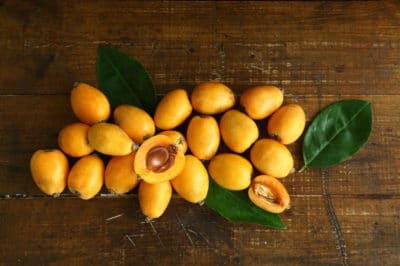Loquats Are Good for You
Here’s a partial list of the nutrients contained in a ripe loquat fruit:
- Pectin, a soluble fiber and natural regularity booster. By binding with cholesterol and carbohydrates, it can reduce your cholesterol levels and prevent blood sugar spikes.
- Vitamin A helps protect your eyes against glaucoma, cataracts and other diseases. It’s also an essential part of your oral health care.
- Six different B vitamins protect your brain, support your immune system, nerve function and metabolism and help you break food down into energy.
- Vitamin C increases your infection-battling white blood cells. It also helps your body build collagen for skin and joint health, keeps your gums healthy and plays a major role in tissue repair.
- Copper, potassium and iron. Copper builds red blood cells, iron assists in blood circulation and potassium relaxes your blood vessels and arteries, lowering blood pressure so your heart doesn’t have to pump so hard.
- Omega-3 and Omega-6, essential fatty acids your body can’t produce on its own.
Loquats provide all these benefits and more, with only 70 calories and 2.5 grams of fat in a 1 cup (340 g) serving.
Loquats on the Tree
Loquat trees (Eribotrya japonica) grow in USDA plant hardiness zones 8 through 10, but they only produce fruit in part of that range. Their flowers appear in fall and their fruit ripens between late winter and very early spring, so winter temperatures determine whether or not they’ll produce a crop:
- Temperatures of 19° F (-7.2°C) or below kill their flower buds.
- Temperatures below 27°F (-2.8°C) kill their open blooms.
- Temperatures below 26°F (-3.3°C) kill their seeds, resulting in fruit drop.
Expert gardener’s tip: Winter cold isn’t the only problem. The fruit of desert-grown trees often develops sunburn if exposed to strong sunlight during an abnormally hot spell.
What Loquats Look Like
With loquat tree cultivars numbering more than 800, it’s not surprising that loquat fruits vary in shape, size and color. They may be:
- From 1 to 2 inches long.
- Round, egg- or pear-shaped.
- Fuzzy or smooth.
- Green when young and apricot, orange or yellow — sometimes with a hint of red — when ripe.
Depending on cultivar and climate, loquats ripen between January and May.
Expert gardener’s tip: Without proper care, a loquat tree grown from seed begins fruiting in about seven years.
Loquat Fruit Flavor
Ripe loquats have juicy, yellow or white flesh and one or more good-sized seeds. Their flavor varies in tartness, sweetness and spiciness.
Sugar Content
The Brix core measures a loquat’s sugar content. A 20 Brix means the fruit contains 20 percent sugar solids. Among commercially grown cultivars,‘FCN #3’ and Thales max out at 23.5 and 22.2 Brix. Spicy-sweet ‘Champagne‘ earns 17.6 Brix. For a more complex flavor, try ‘Wolfe.’ It’s simultaneously spicy, tart and mildly sweet, with up to 15 Brix.
Seediness
Not wild about seedy fruit? Then loquats from these cultivars are the way to go:
- ‘Advance’
- ‘Oliver’
- ‘SES #1’
- ‘SES #2‘
- ‘Sherry’
They average just 1 to 3 seeds, with 88 to 92 percent edible fruit.
Expert gardener’s tip: Loquat seeds contain cyanide compounds that can be toxic in large amounts. Be sure to remove them when eating or processing the fruit.
Harvesting Loquat Fruit
In many areas, including central Texas, loquat trees have naturalized in the wild. If you’re lucky enough to find one, it could mean a free harvest.
Most loquat fruit ripens about three months after the flowers open completely. Leave it on the tree until it changes from green to yellow or orange and starts to soften.
To avoid tearing or bruising the individual fruits, remove them in clusters and snip them apart before eating or processing. They’ll keep for one to two weeks in the refrigerator. Washed, peel and frozen, they’ll last up to six months.
